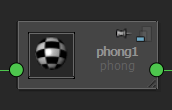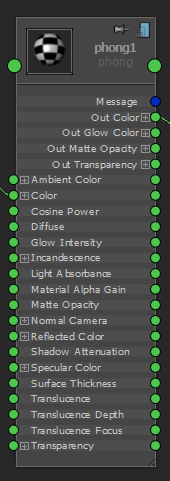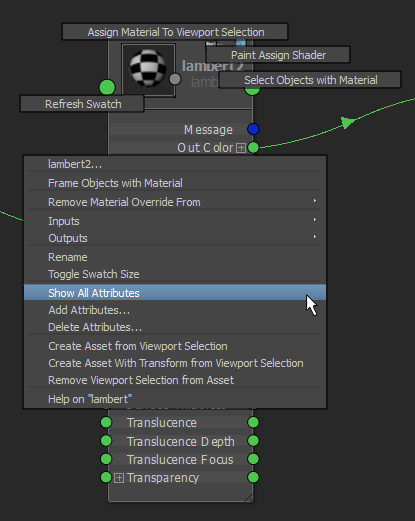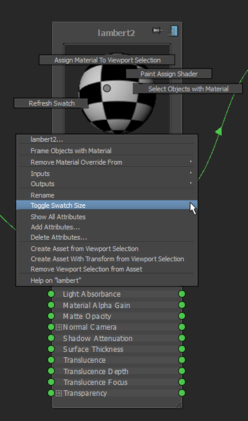
The Node Editor presents an editable schematic of the dependency graph, displaying nodes and the connections between their attributes. It allows you to view, modify and create new node connections. You can access the Node Editor from the Windows menu. (Window > Node Editor).
There are three ways to view nodes within the Node Editor: simple, connected and full.
The simple mode shows one input and one output master port, represented as circles. The  icon also denotes that you are in the simple mode.
icon also denotes that you are in the simple mode.

The connected mode shows the input and output master ports, as well as any connected attributes. These attributes have their
own ports, which are displayed as small circles. The  icon also denotes that you are in the connected mode.
icon also denotes that you are in the connected mode.

The full mode shows the input and output master ports, as well as primary node attributes. The set of primary attributes for
a given node is based on the properties of the attributes such as whether they are keyable or dynamic. The  icon also denotes that you are in the full mode.
icon also denotes that you are in the full mode.
Input attributes are displayed on the left side of a node in full mode. Output attributes are displayed on the right side.
To expand a node's attribute list, click the  located next to the attribute. If an attribute can be connected as either an input or an output, a port is available on both
the left and right sides of the node. For more information on node connections, see Displaying connections.
located next to the attribute. If an attribute can be connected as either an input or an output, a port is available on both
the left and right sides of the node. For more information on node connections, see Displaying connections.

You can select the Show All Attributes option from the node marking menus to temporarily replace the full mode for a node with a listing of all of the attributes. The displaying of all of its attributes is only valid for this draw instance. If you regraph the node, or if you change the view mode of the node, you must re-select this option to see all of its attributes again. See Node Editor Marking Menus for more information about the Node Editor marking menus.

Changing view modes for multiple nodes
You can change the view mode for multiple nodes in one step by selecting the nodes and selecting the desired mode icon in the toolbar. You can also do the same via the menu options (Edit > Simple Mode, Connected Mode, Full Mode) or their shortcuts. See Node Editor Edit menu and Node Editor Toolbar for more information.
In any view mode, you can toggle between a larger and a smaller version of the node swatch by  the node and selecting Toggle Swatch Size from the node marking menu.
the node and selecting Toggle Swatch Size from the node marking menu.

The following table lists the functionality of the Node Editor at a glance.
| To... | Do this |
|---|---|
| Display connections. |
Select a node and click the |
| Create a node. |
Press Tab and enter the type of your node. Alternatively, you can |
| Copy a node into the Node Editor. |
You can |
| Create a connection using connection lines. |
Expand the node to its full mode by clicking |
| Create a default node connection. |
|
| Connect nodes using the Connection Editor. |
|
| Connect a default output to a specific input attribute. |
|
| Delete a connection. |
Drag on a connection line and release the mouse in the background area to delete a connection. Or, you can click the connection line(s)/marquee-select and press Backspace (Windows and Linux) or Delete (Mac OS X). |
| Change an existing connection. |
Drag on a connection line to disconnect and then reconnect with a new input/output. |
| Lock the view. |
Click the Or, you can disable the Add to Graph on Create option from the Node Editor work area marking menu. |
| Resize nodes. |
You can resize any node in any of the view modes: simple, connected, or full. The resize corner |
| Pinning a node to the view. |
You can pin a node so that it stays within the Node Editor view and retains its position and size even after a regraph. Click |
| Assign a material. |
In the scene view, select the object(s) that you want to assign the material to. Then, in the Node Editor, right-click the material to expose its marking menu and select Assign Material to Viewport Selection. Or, you can |
| Graph a node, and add it to the existing network. |
Enable Options > Additive Graphing Mode. Select a node and then click one of the |
| When you select a node in the Node Editor, you do not want it to be selected in the scene view and vice versa. |
Right-click the work area to expose the marking menu and disable the Sync Node Editor / Viewport Selection option. See Selection in the Node Editor for more information. |